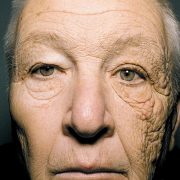But … I Don’t Lay Out In The Sun… I Never Go To the Beach
When thinking about sun exposure, you might envision yourself on the beach or exercising outdoors. But millions of Americans receive a large portion of their sun exposure when they don’t even realize it — in the car, and through indirect sunlight coming through their windows. Also, damage to our skin occurs from daily exposure to free radicals (unstable, highly reactive molecules) caused from television screens, computer screens and fluorescent lights, which are a part of our everyday lives.
For years, dermatologists have observed that patients in the US often have more sun damage (which can lead to wrinkles, leathering, sagging, brown “age” spots and even skin cancers) on the left side of their faces than on the right. Why? Research increasingly points to ultraviolet A (UVA) radiation penetrating through car windows. That is why it is imperative to wear daily professional strength sunblock that is free of toxic chemicals, more commonly used in over-the-counter sunscreen protections, which contain parabens and other harmful ingredients that are absorbed by the body daily.
UV radiation from the sun, associated with about 90 percent of all skin cancers, reaches the earth as long- wavelength UVA and shortwave UV B rays. Glass effectively blocks UVB, and windshields are specially treated to block UVA as well, but a car’s side and rear windows allow UVA to penetrate and do its damage.
UV exposure is cumulative, and research has proven that skin exposed to sun shining through window glass, even in the office, can over time lead to significant skin damage. The UV exposure we receive driving a car especially adds up. In a US study by Singer, et al, the researchers found asymmetric photo damage (sun- induced skin damage) on the face, with more brown pigment (color) and deeper wrinkles on the left. The more time subjects spent driving a vehicle, the more severe their photo damage on the left side. Reinforcing this research, in countries where the driver’s side is the right side, people tend to develop more sun damage and skin pre-cancers on the right. Certain pre-cancers can turn into squamous cell carcinoma, the second most common form of skin cancer.
“An ounce of prevention is worth a pound of cure” definitely applies to protection from the sun. When performing facials in Fort Lauderdale, I often ask clients what is their number one skin complaint. Hyper-pigmentation and dehydration from years of sun damage is always at the top of the list. Clients usually will have many excuses as to why ‘sun blocks don’t work’ or ‘irritate my skin.’ I use this time to explain to them that over-the-counter inferior sun blocks are most often the culprit of their unpleasant experiences using sun blocks. And I like to introduce them to the variety of professional sun blocks, and other products, like Vitamin C and hyaluronic acid that will boost the efficacy of sun blocks that are sold exclusively by estheticians, dermatologists, and plastic surgeons. These professional grade products from companies like Image Skincare, Minus Sol and PCA Skin come in a variety for every type of skin. Some are tinted, matte, or sheer. Others have moisturizer, some absorb oil for acne or oily skin, and others are water resistant and sweat resistant for exercising outdoors.



